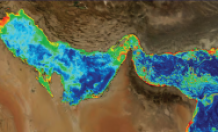Articles

Chlorophyll concentrations captured by the MODIS Aqua sensor (NASA) representing a bloom of the harmful algae Margalefidinium (Cochlodinium) spp. (Courtesy of Raphe Kudela and NASA).
Arabian Gulf (on left) connected via the Strait of Hormuz to the Sea of Oman (on right).
Gulf HAB workshop proceedings and links to presentations are now available
Predicting HABs in a complex, changing world is difficult – there is no one solution for every situation.
The Arabian Gulf is a unique hypersaline semi-arid environment with extensive shallow regions < 20 m deep off the coasts of Kuwait, Bahrain, and the United Arab Emirates. Evaporation rates in the Gulf greatly exceed freshwater inputs by a factor of ~10. Water volume in the Gulf is maintained by seawater inflows through the Strait of Hormuz from the Sea of Oman. Harmful Algal Blooms (HABs) are often shown to extend into the Arabian Gulf from the Sea of Oman and the Arabian Sea.
In the Arabian Gulf, finfish aquaculture alone is projected to grow by over 7% between 2018 and 2024. However, the growth of the aquaculture industry is threatened by HABs, which are increasingly observed at aquaculture sites around the globe, with some HAB species causing mass fish mortalities. Numerous mass fish kills have been recorded in the Arabian Gulf and Sea of Oman and many of these coincide with blooms of ichthyotoxic HAB species and/or high biomass blooms that subsequently decay and cause oxygen depletion in the water column.
A virtual workshop was held in February focused around the development of an early warning system for Harmful Algagl Blooms (HABs) in the Arabian Gulf.
The workshop explored existing knowledge and data on Harmful Algal Blooms (HABs) and impacts on fisheries and finfish aquaculture in the Arabian Gulf and Sea of Oman.
Day 1 of the workshop focused on “Understanding the susceptibility of the Arabian Gulf and Sea of Oman to harmful algal blooms and impacts on fish health and food safety”.
Day 2 focused on “Developing early warning systems (EWS) for HABs for mitigating impacts on fisheries and aquaculture”.
The organisers are pleased to announce that the Gulf HAB workshop proceedings and links to video recordings ofpresentations are now available via the GlobalHAB website. Click here (proceedings and link to videos at bottom of page).
Date: 23 March 2022
